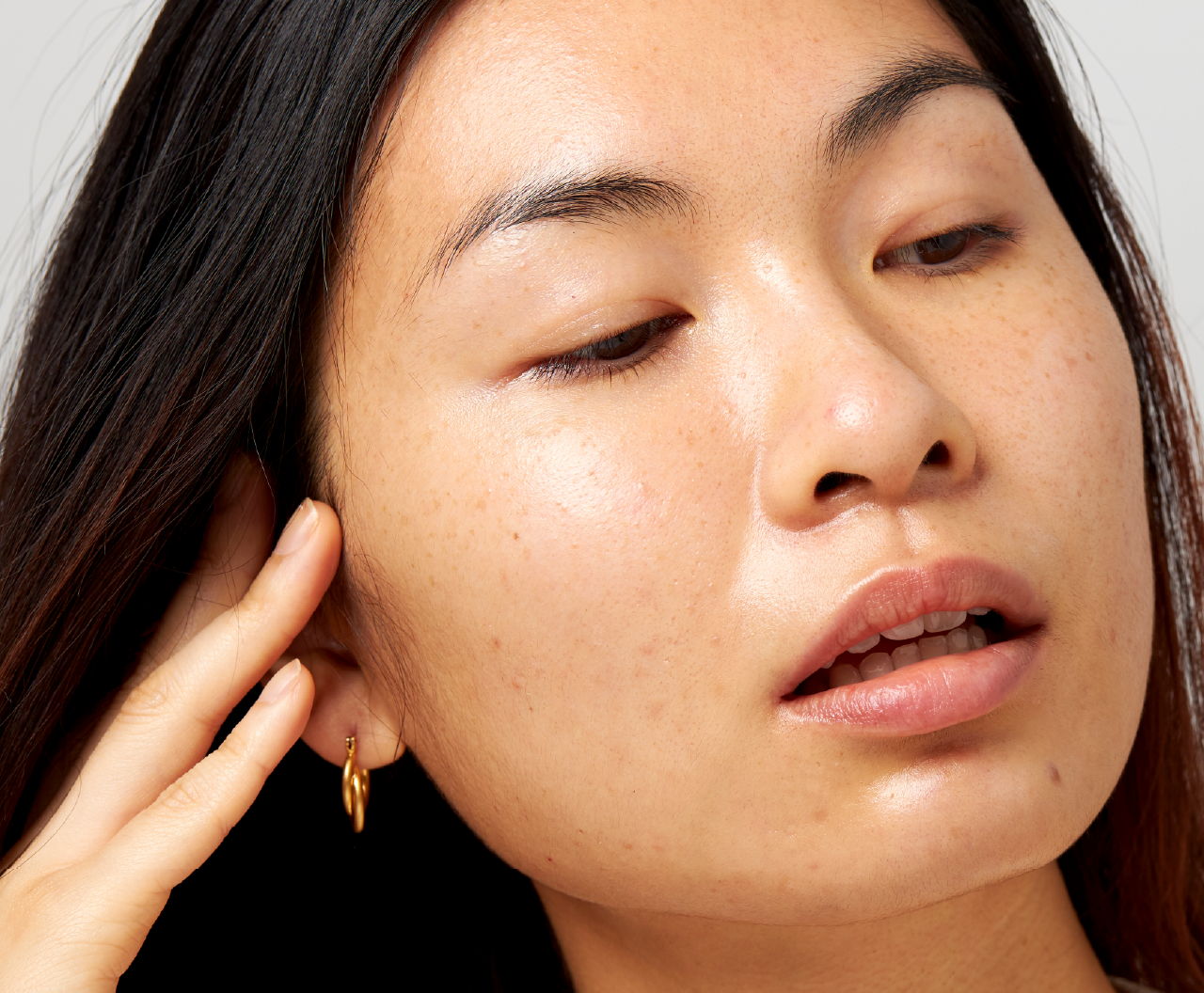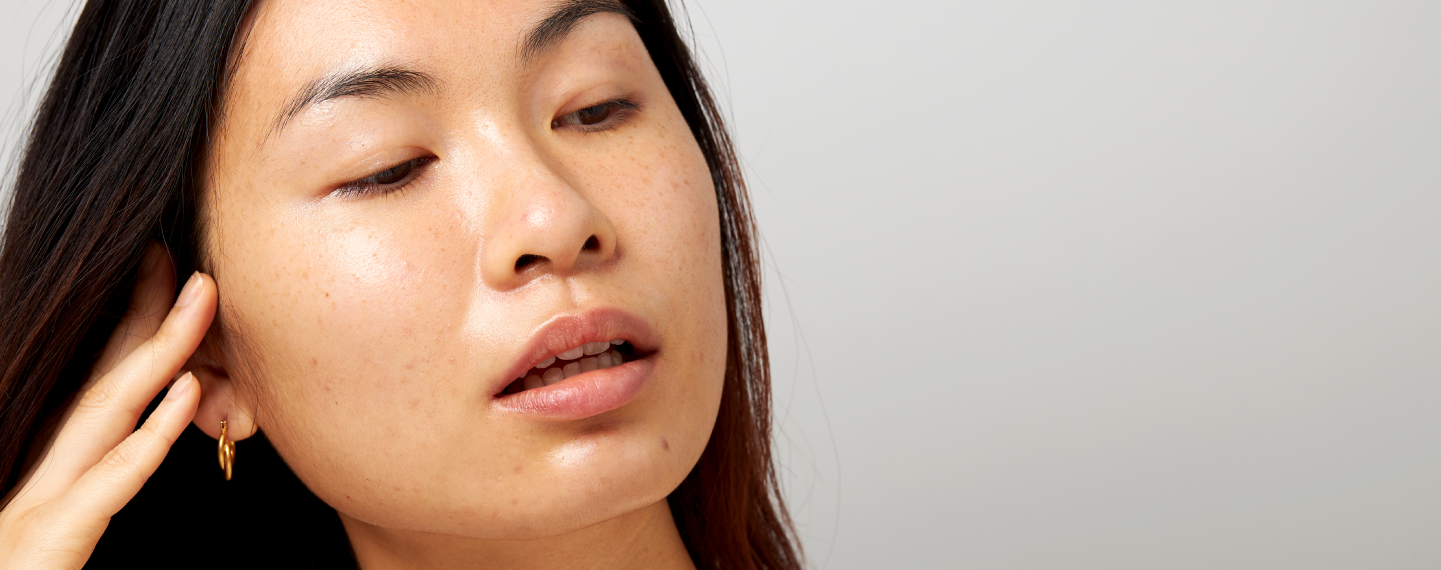Education
How to get rid of oily skin


SHARE
Education
How to get rid of oily skin
Medically reviewed by Kristin Hall, FNP
Written by Apostrophe Team
Last updated 4/1/2024
When it comes to your skin, there’s a not-so-fine line between a healthy, radiant, glowing look, and a shiny, oily sheen.
It can feel frustrating trying to find that elusive, healthy balance that sits between a dry, dull epidermis and the kind of shine that makes you want to reach for another scrub.
Oily skin is a frustrating problem, but medically it can be the symptom of a few different (and even opposite) problems.
If you have excessively oily skin or acne, there’s definitely an imbalance that needs to be addressed, but to understand what the imbalance is (and how to fight it), you first need to understand why your skin has any oil in the first place.
The Role of Oil on and in Your Skin
Oil, sebum, lipids — they’re all names for an often misunderstood part of your everyday skin health. Oil is an important product in the upkeep of your healthy skin.
Your pores produce oil, or sebum, through the sebaceous gland. That gland is there in the first place to produce oil, which can help your body wick away dead skin cells. And when everything is working correctly, it keeps the dead skin from accumulating and helps your overall skin look healthy and glowing.
But things go awry, and when part of the process gets out of balance, oil production can go out of whack. Suddenly, your pores are overflowing with an oily buildup — one of the common ways acne bacteria can prosper, form pimples, and lead to a breakout.
The Not-So-Simple Oily Skin Problem
It may seem counterintuitive, but your oily skin may not be so easily solved by, well, drying it off.
Oily skin suggests an imbalance in the natural processes carried out by your skin, namely the dislodging of dead skin cells and the healthy regrowth of new layers.
But increased sebum production and excess sebum can be caused by a lot of things, from closed and clogged pores, to overly dry skin, to vitamin and protein deficiencies, and even imbalances of a hormone like androgen. There’s really no one source — and it’s not so simple as scrubbing harder, or cutting greasy foods out of your diet.
It would make sense then that the remedy isn’t just to dry the skin out further, but to treat the cause of the excess oil. That way you can return to a balanced, healthy look with
Here are some ways to do just that.
How to Get Rid of Oily Skin
Remove the Oil
The obvious first step might just be to remove the oil. Products like blotting papers, toners with astringents like witch hazel, or a clay mask, are all products that have been proven effective for removing oil from skin as part of a daily routine.
In one study that involved a small group of 30 people aged 12 and 34 used a three-step acne process (an over-the-counter cleanser, toner, and acne treatment), and noted significant improvements in acne by the end of the six-week period.
The toner used specifically included witch hazel.
These may only treat the symptoms, but they’re a start in regaining some balance.
Moisturizing
It may sound counterintuitive, but properly moisturized skin is less likely to be a vulnerable playground for acne vulgaris and acne bacteria. Excessively dry skin leads to a buildup of dead skin cells, which are normally removed by sebum as they fall away from the epidermis inside your pores.
When they don’t fall away properly, sometimes your sebaceous gland will go into overtime, producing extra oil to try and push the dead stuff out to make room. Suddenly you’ve got a flood of oil, which is a ripe breeding ground for acne bacteria in the pore, and an unattractive problem outside the pore.
Your skin may be dry from a number of things, including the weather, your diet, your age, your skin care routine, or simply because you’re cleaning it too often.
One simple solution is to add a moisturizer to your skin care routine.
You can use traditionally accepted products like aloe vera, but a more scientifically proven method is to use a moisturizer containing hyaluronic acid, which has been shown to help your skin better retain moisture.
Moisture retention can help rebalance things when using an aggressive cleansing skin care routine, or experiencing other factors listed above that contribute to dryness.
Exfoliating
The easiest way to help remove that buildup of dead skin cells (and excess oil) is proper exfoliation. You can exfoliate with physical procedures like washing your face and scrubbing, or use a chemical method with skin care products including retinoids.
Retinoids (synthetic vitamin A compounds composed of retinol and retin-As) are designed to help get rid of dead skin and have also been proven to help get your skin started on regrowth faster. While retinol is found in many OTC products, you can get a prescription for tretinoin, which is a higher strength retinoid.

PRESCRIPTION TRETINOIN
Target acne, dark spots, and signs of aging with this science-backed ingredient.
Tretinoin is considered a mainstay in the treatment of acne, and one that dermatologists have relied on since the sixties.
And there are benefits beyond helping you get your oil problem under control.
Tretinoin has been shown not just to help remove buildup, but also to improve the synthesis of collagen, though side effects can include irritation and peeling in certain cases with certain skin types.
There are also oral retinoids to consider, which may provide long term benefits and help control excessive oil production.
Learn more about retinoids, and see if they’re right for you.
Focus on Your Lifestyle: Diet, Water Intake, and Stress
It’s not just your skin care routine that can decide how much sebum you produce. External factors like a high glycemic diet, poor hydration, and general stress can wreak havoc on your skin too, by throwing off the natural rhythms.
The best way to prevent those effects, unfortunately, is to never have stress, poor diet, or poor water intake, which can be difficult lifestyle qualities to maintain with a busy life, difficult job, and other factors.
Beyond consulting medical professionals about nutrition and stress, though, you can do limited things to rein in the bad habits like track your water intake, avoid dehydrating foods, and eat meals with low glycemic index and glycemic load numbers, which studies show correlates to lower acne outbreaks.
It’s unclear if sugar and the related glycemic load and glycemic index ratings affect sebum production, but there’s plenty of research to suggest that they’re related to acne, which is caused by, among other things, excess sebum.
Generally speaking, though, a healthier diet, less stress, and more water are good for every part of your body, so if you’re not already maintaining a healthy diet and healthy lifestyle, consider making those changes.
Final Thoughts
Figuring out the root cause of your excess oil is the smart first step to treatment, as deploying the wrong treatment option (e.g. causing more dry skin when dry skin is the root cause) can make things worse, or at the very least, make your sebum problem no better.
It’s always best to consult with a healthcare provider if you think your oily skin is extreme, or if your oily skin also includes moderate to severe acne.
Retinoids may be a viable solution for you, or your answers may lie in proactive lifestyle changes. Either way, there are a multitude of tools at your disposal to get your oil back under control and downgrade that stick sheen to a vibrant glow.
References:
Like what you just read? Sign up for our email list to get the scoop on skincare science delivered straight to your inbox.

Deep Dives
A dermatologist shares his thoughts on the recent studies about benzoyl peroxide and benzene.
Read More
Education
What is milia?
What is milia? Today, we’re jumping into one type of bump that you may have heard about most commonly in infants — milia.
Read More
Education
Best moisturizer for acne-prone skin
If you have combination acne-prone skin, figuring out which moisturizer is best for your skin might be tough. In this guide, we break down the best moisturizer for combination, acne-prone skin.
Read More